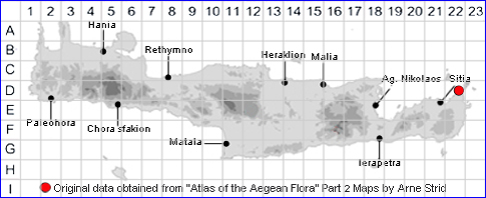
SILENE HOLZMANNII
Family and Genus:- See- CARYOPHYLLACEAE/Sect. BEHENANTHA
Common Names:- None
Homotypic Synonyms:- None
Meaning:- Silene (Gr) A name used by the Greek philosopher Theophrastus for
catchfly.
Holzmannii (L) Probably for Theodor Heinrich Hermann von Holzmann
(1822-1902). German botanist from Dresden who lived most of his life in Greece.
General description:- Herbaceous plant. with erect, hairless, simple or branched
stems.
Stems:-
1) 15-20 cm, glabrous, usually single and strictly erect.
Leaves:-
1) Opposite, simple, lanceolate to oval, glabrous, slightly bluish green.
2) Cauline, glaucous, usually imbricate.
Flowers:-
1) Inflorescence, a lax dichasium, lowest pair of internodes of the fruiting
inflorescence 2-4 cm; next pair very short; flowers (except the lowest one)
overlapping the pedicels, stout, usually shorter than calyx.
2) Calyx, 11-17 mm, ovoid in fruit, with 5 whitish sepals with brown red veins.
3) Stamens, 10 including 5 a little shorter.
4) Styles, 3 whitish, with reddish, anastomosing veins above.
5) Petal-limb, scarcely exserted 3-64 mm, not broader than long, purplish-pink,
divided more than halfway into linear, parallel lobes.
.
Fruit:-
1) Capsule, 9-10 mm, ovoid; carpophore 1-2 mm, very stout.
2) Seeds, c. 1·5 mm, indehiscent, echinate.
Key features:-
1) Calyx, glabrous.
2) Capsule, crowned by indurate style bases, dehiscent at maturity.
3) Petal-limb 3-4 mm, purplish-pink.
Habitat:- Rocky slopes and flats with coastal dry open shrubby vegetation. 0-30 m,
confined to small, ungrazed islets.
Distribution:- Endemic to a small area of the S. Aegean. A small island specialist
restricted to the sublittoral zone. On Crete currently know only from a small island
in the far east. Related to S behen.
Flowering time:- Apr-May.
Photos by:- Stavros Apostolou
SPECIES DESCRIPTION
